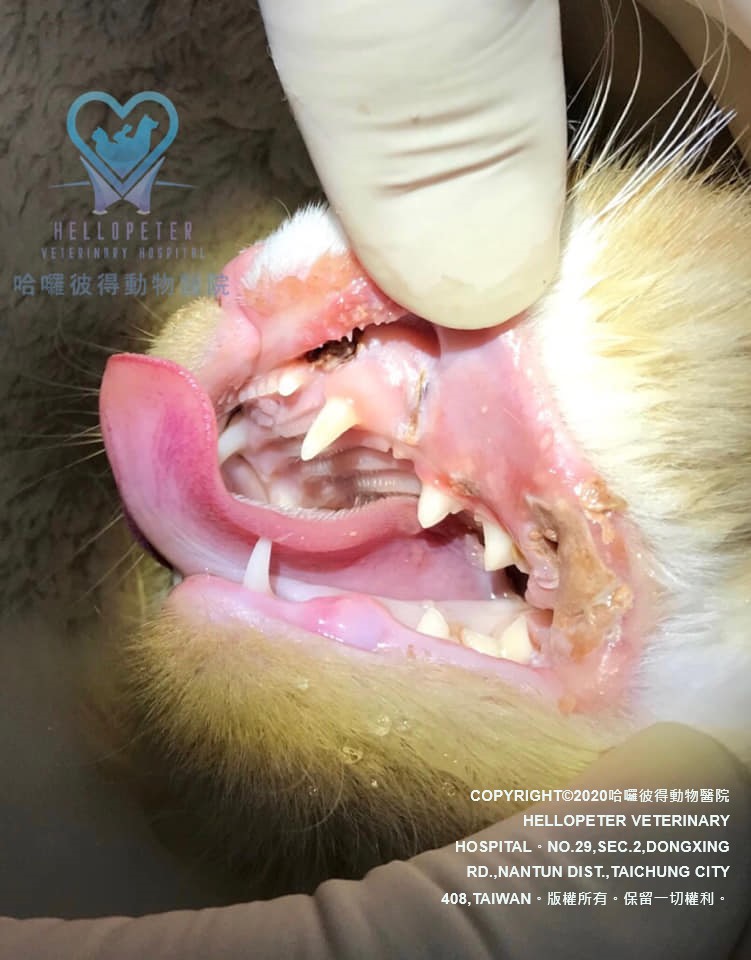 In veterinary dentistry clinical practice, oral burns caused by pets biting or licking objects are quite common. These burns not only affect the oral cavity itself but can also lead to complications in other parts of the body, such as non-cardiogenic pulmonary edema (ARDS).
In veterinary dentistry clinical practice, oral burns caused by pets biting or licking objects are quite common. These burns not only affect the oral cavity itself but can also lead to complications in other parts of the body, such as non-cardiogenic pulmonary edema (ARDS).
Oral burns can be broadly classified into five categories:
★Electrical Burns
Typically caused by biting electrical wires. For example, the image shows a Munchkin cat that suffered electrical burns from chewing on the wires of a home intercom system.
★Chemical Burns
Result from ingesting various strong acids or alkalis, such as pesticides, cleaning agents, etc.
★Hot Liquids Burns
Caused by boiling water, hot oil, or hot soup.
★Fire Burns
Result from any explosion or combustion, such as gas or alcohol.
★Contact Burns
Occur by touching the surface of any hot object, like a hot pot or exhaust pipe.
Since pets do not consume hot food willingly, the causes of burns are usually Electrical Burns or Chemical Burns. The actual damaged area caused by oral burns is often larger than what is visible to the naked eye. The affected tissue visibly ruptures and collapses, and due to blood clots, hematomas, and blocked blood vessels, oxygen and nutrients cannot reach the affected area. This leads to continuous necrosis of the damaged but still surviving cells, causing the lesion to expand until the necrotic tissue completely falls off, allowing granulation tissue to grow and heal from the base.
Oral wounds are less obvious in their progression compared to other related complications, making them easily overlooked and delaying timely treatment.
Electrosurgery, a technique commonly used in surgical procedures, is a form of localized Electrical Burns. In human dentistry, it is occasionally used in minor gingival contouring surgeries. After the healing of burned areas, continuous contraction of scar tissue may lead to various sequelae, including shallow oral vestibule, stiff and adherent tongue, dental misalignment, and poorly developed jawbone.
In human dentistry, to prevent the contraction of scar tissue, auxiliary devices such as Commissure Splint or Angular Retractor are used during treatment. Currently, there seems to be no veterinary equivalent, making oral debridement after animal burns crucial. It is essential to remove necrotic tissue as much as possible and be prepared for multiple debridement sessions in the short term. Coupled with antibiotics, fluid therapy, and pain control, this approach can effectively accelerate healing, although complications may arise. Therefore, it is strongly recommended for owners to have animals with burns observed in the hospital.
#口腔燒燙傷 #Oral Burns
#電灼傷 #Electrical Burns
HelloPeter Veterinary Hospital
Director : Dr. Chung-Wei Chen (Dr. Richard Chen)
Column: 【Dr. Chen Talks About Teeth and Oral Cavity】www.hellopeter.com.tw/contents-3.html
Official Website: www.hellopeter.com.tw
Phone: +886-4-2472-8828
Address: No. 29, Sec. 2, Dongxing Rd., Nantun Dist., Taichung City 408, Taiwan
Official Website: www.hellopeter.com.tw
Hospital Hours: Monday to Friday 10:00~20:00 (by appointment only), 12:00 to the end of all appointments on Saturday, Closed on Sunday
#動物牙科 #動物口腔外科 #MGRS #牙齦黏膜置換手術 #貓口炎 #台中獸醫院 #牙科獸醫推薦 #根管治療 #Endodontics #假牙膺復 #動物假牙 #動物植牙 #狗貓齒顎矯正 #HelloPeterVeterinaryHospital
#PeriodontalDisease #牙周病



 In veterinary dentistry clinical practice, oral burns caused by pets biting or licking objects are quite common. These burns not only affect the oral cavity itself but can also lead to complications in other parts of the body, such as non-cardiogenic pulmonary edema (ARDS).
In veterinary dentistry clinical practice, oral burns caused by pets biting or licking objects are quite common. These burns not only affect the oral cavity itself but can also lead to complications in other parts of the body, such as non-cardiogenic pulmonary edema (ARDS).